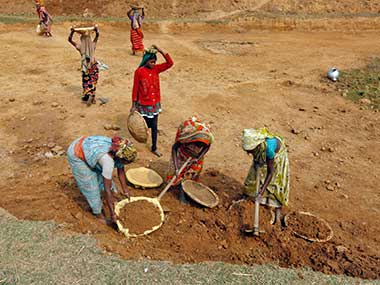DBT (direct benefit transfer) has redefined the public service delivery system, cabinet secretary P.K. Sinha claimed at a workshop on DBT last week. It has, he said, increased trust in the government machinery, since people were now getting the welfare payments due to them without hassles or bribes.
The first part of the statement is, no doubt, true. DBT does bring about a paradigm shift in the delivery of welfare benefits. It does, as Sinha said, significantly bring down duplication and leakage and increases efficiency. But while it does bring huge gains to the government, is the beneficiary experience as painless as it is made out to be? That question needs to be asked as the government’s National DBT (direct benefit transfer) Portal is now up and running.
This will bring together, on one platform, information relating to all DBT programmes by the central government. Right now, information is scattered across individual departments and there is little sense of the various benefits a family is getting. This portal will allow such mapping, down to the district level. It will also enable analytics – how many DBT payments are being made in one district, what kind of payments, and the like. What’s more, families and individuals can also keep track of their payments through this portal.
The portal will start with just information from central government ministries and departments. Over time, the centre hopes, states will also come on to this platform, which will help eliminate duplication and availing of the same benefits from different sources, which even insistence on Aadhaar may not do.
For example, someone who has a ration card in his village in one state can apply for and get a ration card in another state where he is employed (the requirement of getting a no-objection certificate from the home state can be easily managed). Since the food departments of states are not connected with each other, the same Aadhaar card can be used for two cards in two states. If states come on to this portal, departments of different states can start talking to each other and to central government departments through this portal, reducing the scope for such duplication.
The portal is part of a massive DBT push that the government is driving. There is no doubt that the whole DBT initiative, the first feeble steps relating to which were taken during the last years of the United Progressive Alliance government, has really gone places under the Narendra Modi government.
A DBT cell in the finance ministry’s expenditure department has been converted into a DBT Mission under the Cabinet Secretariat. As many as 74 schemes run by 17 ministries have shifted to DBT payments. As much as Rs 1.2 lakh crore have been disbursed among 30 crore beneficiaries till now.
All ministries making welfare payments have been told to shift to DBT mode by September 30; they, as well as Union Territories, also have to set up DBT cells by then. All state welfare schemes where the centre is making payments will also have to shift to DBT mode by end-March 2017.
So that’s all the good news. But the DBT drive is not without its share of problems, and beneficiaries are not overwhelmingly enthused as Sinha would like us to believe.
At that workshop for states he spoke at, ground-level implementation problems did get highlighted.
Take the case of DBT payments for MNREGA wages. That has often been touted as a big success, but, according to accounts of some of the delegates, a representative of the rural development ministry pointed out to a 40 per cent failure rate in the Aadhaar-based bank transactions. Money goes into individual accounts through the National Payments Corporation of India (NPCI) platform and this, it was reportedly pointed out, is not linked to all banks, certainly not the destination banks.
Delegates also pointed out that even when funds get credited into a beneficiary’s account, getting the money in hand is still problematic. The banking correspondent model just does not seem to be working. There is an inter-operability issue – the banking correspondent of one bank is not always able to make payments to someone in a village who may have an account in another bank. At the valedictory session, there was frank admission that 70 per cent of the payments made through micro ATMs and banking correspondents are failing. There are rural internet connectivity issues as well, which put hurdles in authentication of biometrics as well as financial transactions.
But the government is not only alive to these issues, it is also working overtime to sort these out. The decision on India Post as a payment bank and on micro ATMs may have been delayed but has finally been taken. The rural optic fibre rollout is being fast-tracked.
If DBT has to be the game-changer it is being made out to be, the pace of all this should not slacken.


)




)
)
)
)
)
)